DnB drum patterns can seriously elevate your tracks, there’s no doubt about it.
They bring intensity, drive, and that all-important groove that makes drum and bass tracks stand out in any playlist.
Plus, they can completely transform the energy of a song and keep listeners hooked from start to finish.
If you want to be on point when laying down DnB drum patterns, you’ll have to learn not only the basics but also the more advanced techniques that add depth and complexity.
That’s why we’re breaking everything down for you today, like:
- Setting the perfect tempo for that drum and bass sound ✓
- Kick and snare placement ✓
- Using ghost snares for groove ✓
- Layering drum sounds for dimension ✓
- Chopping and manipulating breakbeats ✓
- Sound design for powerful drums ✓
- Automating FX for dynamic changes ✓
- Creating smooth transitions with reverse hits ✓
- Incorporating polyrhythms for complexity in your drum pattern ✓
- Much more about DnB drum patterns ✓
After this article, you’ll be able to create killer DnB drum patterns that even the most seasoned producers will appreciate.
You’ll be able to lay down rhythms that cut through any mix and keep your listeners hooked, too.
Plus master essential techniques that make your tracks punchy, dynamic, and professionally polished.
This way, your music stays fresh and energetic while standing out in the crowd.
Table of Contents
- What Makes DnB Drum Patterns So Special?
- The Fundamental Elements of DnB Drums: Breaking it Down (Step-by-Step)
- #1. DnB Tempo: Setting the Right Speed
- #2. Kick Drum Patterns: Power and Precision
- #3. Snare Drum: Creating that Signature DnB Snap/Funky Feel
- #4. Hi-Hat and Cymbal Work in DnB
- #5. The Role of Ghost Notes in DnB Patterns
- #6. Drum Programming Techniques
- #7. Layering Drum Sounds: Depth and Dimension (A Deeper Look)
- #8. Breakbeats: The Backbone of DnB
- #9. Drum Sound Design for DnB
- 6 Bonus Tips For Creating DnB Drum Patterns
- Tip #1: Use Subtle Variations in Hi-Hat Velocity for More Realism
- Tip #2: Experiment with Triplets and Quintuplets to Add Swing
- Tip #3: Add Reverse Cymbals or Snares for Transition Effects
- Tip #4: Incorporating Drum Rolls and Fills to Build Energy
- Tip #5: Using Many Unison Voices for a Fuller, Wider Drum Sound
- Tip #6: Polyrhythms
- DnB Drum Patterns: Final Thoughts
What Makes DnB Drum Patterns So Special?
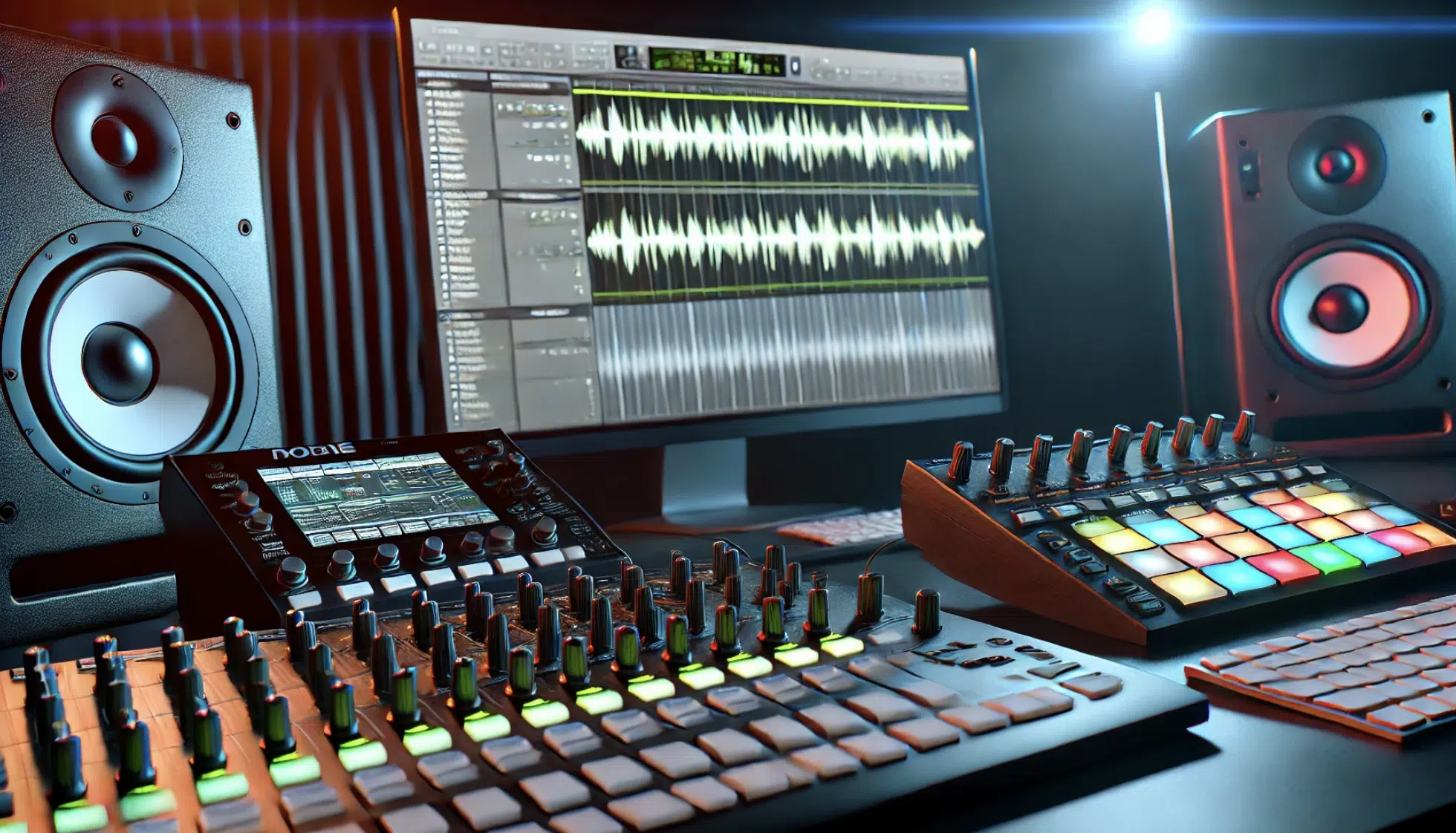
When it comes to DnB drum patterns, there’s something electrifying about their fast-paced, energetic flow that is undeniable.
These drum n bass patterns have that signature intensity that drives people crazy 一 making each drop feel more powerful than the last.
With a foundation that heavily relies on syncopation and intricate rhythms, a DnB drum pattern gives you all the room in the world to play around/experiment.
The blend of fast, rolling breaks, heavy bass drum patterns, and tight snares go crazy everytime… if you know what you’re doing, of course.
But don’t worry, we’ll be breaking it all down today (in detail) so you can immediately go knock out your own patterns and skyrocket your drum and bass production skills.
The Fundamental Elements of DnB Drums: Breaking it Down (Step-by-Step)
To kick things off, let’s dive into what exactly makes a DnB pattern so hypnotic. By breaking down each element, from the tempo to the bass drum, you’ll get a solid understanding of how to build show-stopping drum and bass tracks from the ground up.
#1. DnB Tempo: Setting the Right Speed

The tempo is one of the most key elements when creating killer DnB drum patterns.
Typically, drum and bass tracks sit around 170-180 BPM, but even within that range, the exact BPM you choose can have a huge impact on the feel of your drum patterns.
- For a fast-paced, energetic track, aim for the upper end of 178-180 BPM, which is perfect for intense, high-energy bass drum patterns.
- If you’re going for a more liquid, melodic feel (that liquid producers are all about), try starting with a slightly slower tempo, around 170-172 BPM.
This gives you more space for intricate drum sounds and catchy melodies.
Always remember, the speed you choose affects the pace of your DnB drum pattern as well as how much room you have to layer additional bass sounds and drum breaks.
You always want to tweak your BPM to match the exact vibe you’re going for because, if you’re a DnB music producer, or want to become one, it all starts with the right tempo.
Side note, if you’re unsure, drum breaks are simply sections of songs where the drums play solo. You can sample and loop them to create your rhythmic foundation.
#2. Kick Drum Patterns: Power and Precision
The kick drum forms the backbone of any solid DnB drum pattern, bringing the punch and drive that propels the track forward. Let’s break down how to place, syncopate, and layer your bass drum to create both power and precision in your drum and bass tracks.
-
Placement of the Kick in a Standard DnB Pattern
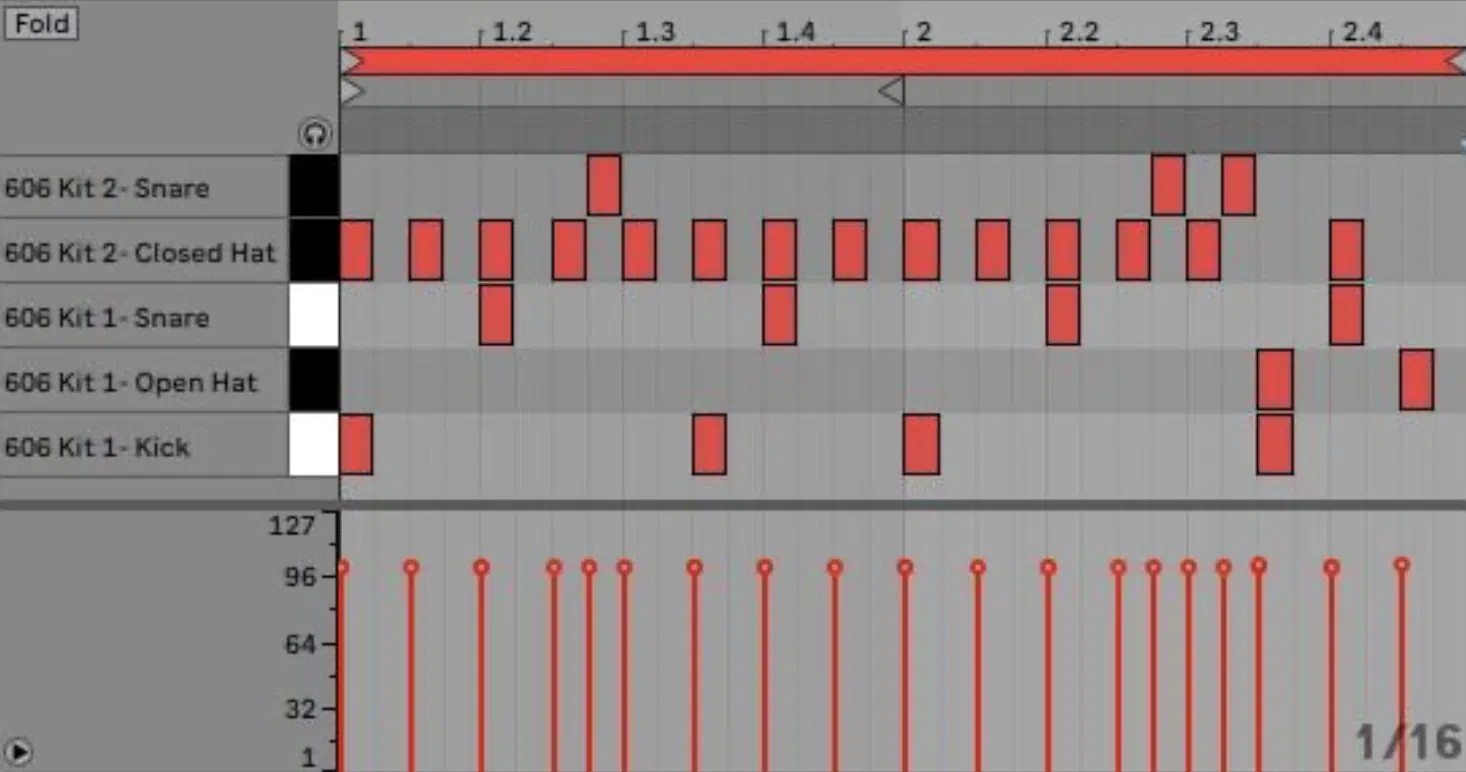
In most DnB drum patterns, the bass drum is placed on the first beat of each bar to give the track a solid foundation.
You’ll also want to place a second kick slightly off the third beat 一 this syncopation creates that driving momentum characteristic of DnB.
To add variation, try placing additional kicks on the offbeats in every second bar, which adds a subtle yet impactful rhythmic twist.
A good starting point for your bass drum pattern in a typical drum and bass track is kick on beats 1 and 3, so begin with that.
NOTE: If you’re using DAW software like FL Studio, you can quantize these kicks to a 1/4 or 1/8 note grid for tight precision.
-
Syncopation and Rhythmic Variations in Kick Patterns
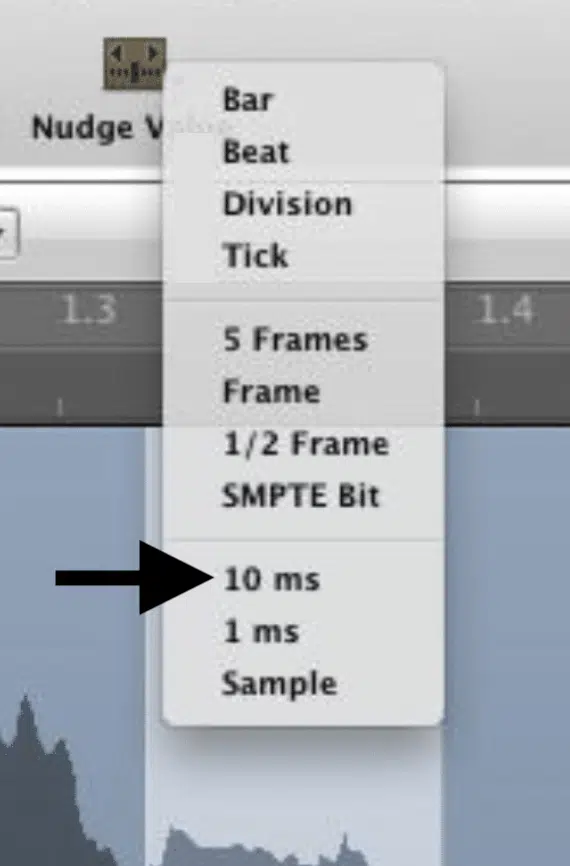
Syncopation is key to giving your DnB drum patterns more complexity.
Instead of always relying on straightforward kick placement, try shifting the bass drum slightly off the grid by a few milliseconds using your DAW’s nudge function.
Start with like 10-20ms and take it from there, don’t go too crazy.
This will create a more dynamic feel and keep the rhythm from sounding too rigid.
Also try removing the first kick in every second bar to introduce empty space, which can add breathing room (common with drum and bass production).
Plus, it highlights other drum sounds in the mix, which is always a plus.
-
Enhancing Low-End Punch: Layering Kicks for MAX Impact
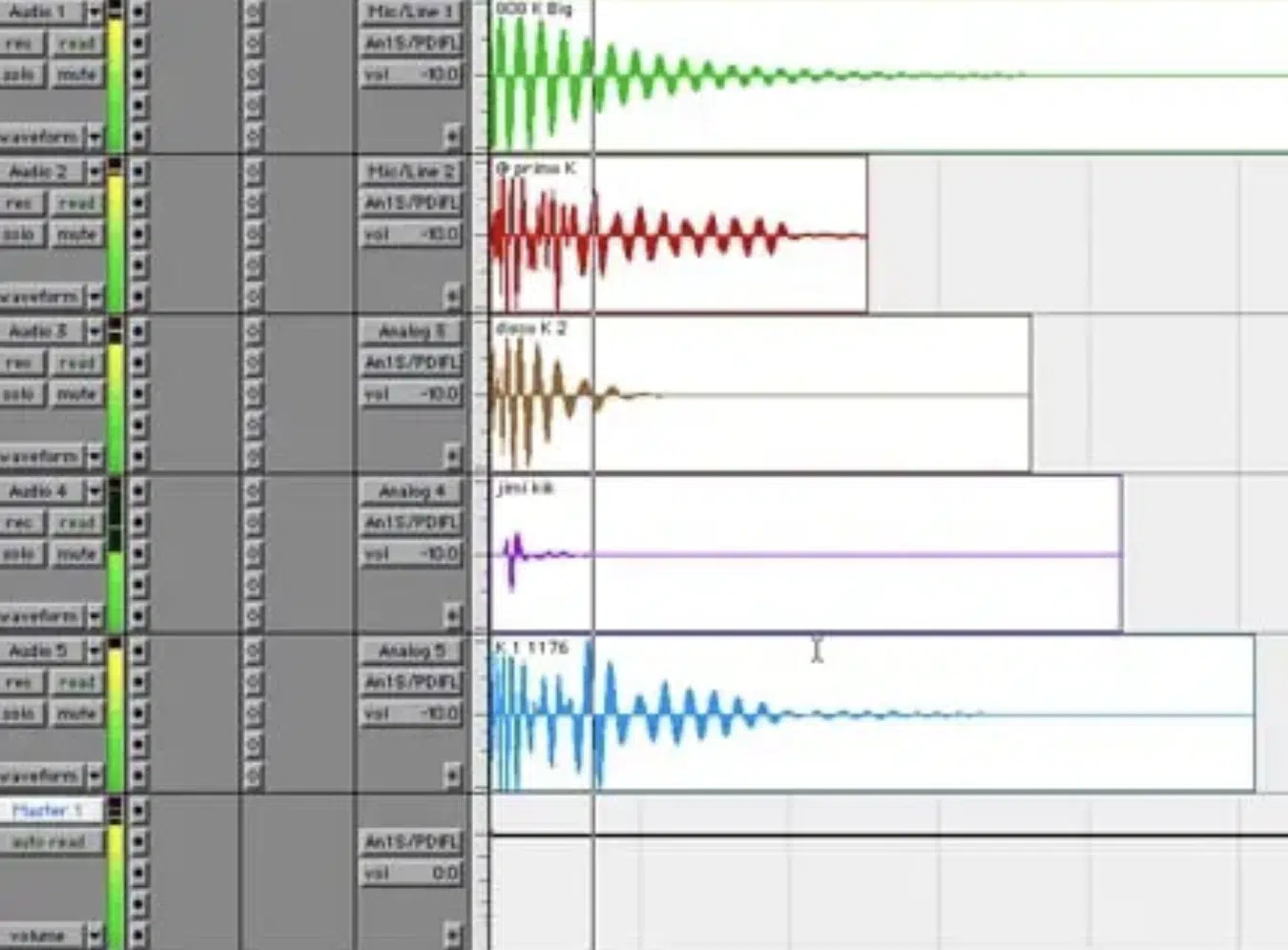
To really enhance the low-end punch of your bass drum pattern, try layering multiple kick samples.
For example, start with a sub-heavy kick for the low-end (EQ around 40-60 Hz), then layer a punchier midrange kick on top (EQ around 120-150 Hz) to give it more body.
You can also sidechain the kicks to your bass sounds (or other sounds), which helps the kick cut through the mix without clashing in the low end.
Lastly, adding a subtle high-pass filter on the midrange kick layer at around 80 Hz can clear up the low-end muddiness while still providing impact.
It’s all about enhancement without disaster, so to speak.
#3. Snare Drum: Creating that Signature DnB Snap/Funky Feel
The snare is another VIP element that will give your DnB drum patterns that distinct, high-energy feel that drives the rhythm. So, let’s break down snare placement, rolling snares, and layering techniques to achieve that iconic drum and bass snap.
-
Snare Placement: The 2 and 4 Rule in DnB
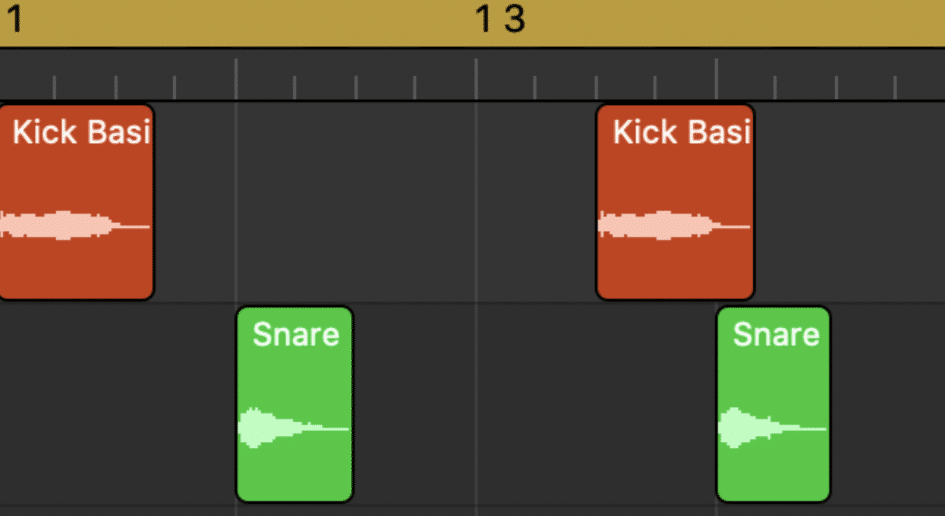
In most drum and bass tracks, the snare is placed on the second beat and fourth beat of each bar.
This 2-and-4 rule is super important when it comes to DnB drum patterns because it locks in the rhythm 一 creating a sense of forward motion and energy.
For a more dynamic feel, you can accentuate the second snare slightly louder than the first, for example adjusting the velocity to:
- Around 90% on the first snare.
- Around 100% on the second snare.
To add depth, try slightly panning the first snare 5-10% to the left and the second snare to the right, which will help widen the stereo field.
Also, incorporating ghost snares between the main hits at a lower velocity (around 30-40%) can create a more intricate groove without cluttering the main snare rhythm.
-
Snare Rolls: Techniques to Add Energy
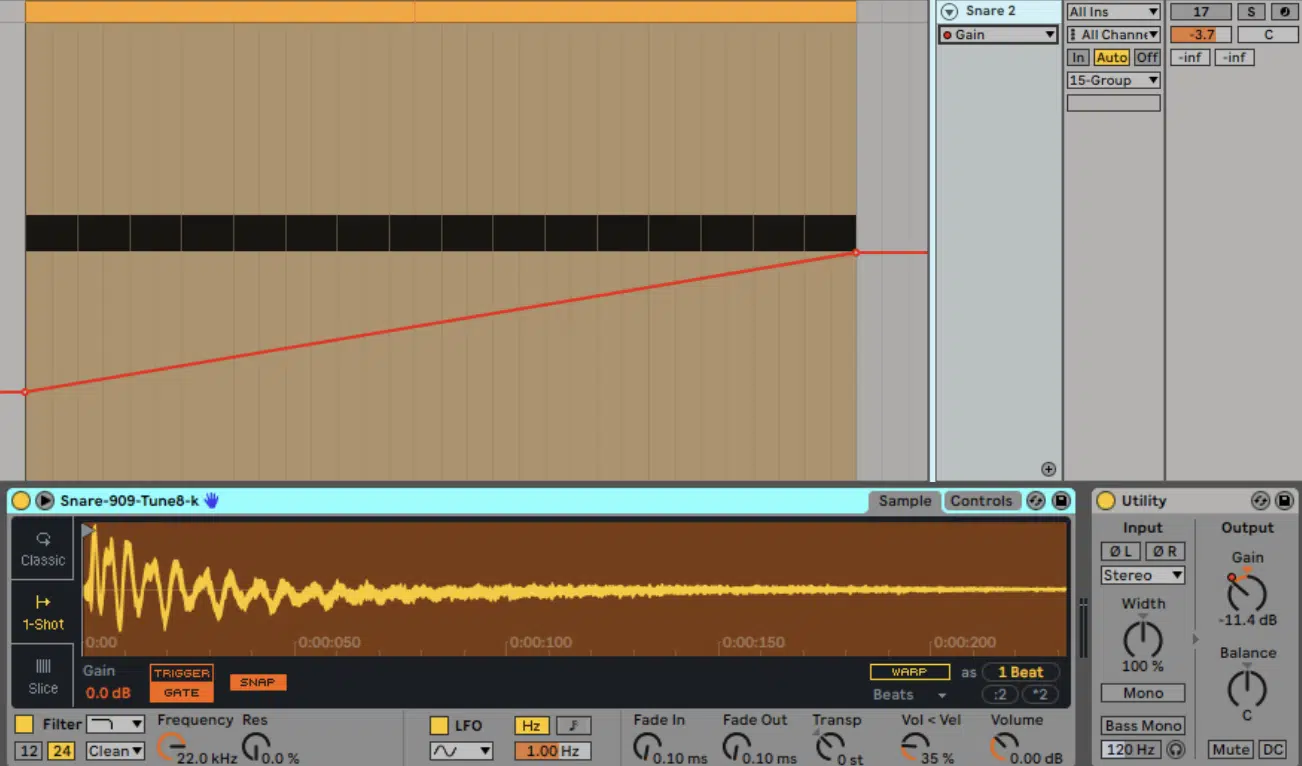
Rolling snares are one of my favorite ways to inject energy into a DnB drum pattern, especially in build-ups leading to the second drop.
To create a rolling snare effect, you can program sixteenth notes or thirty-second notes leading up to a transition, whatever works for your specific track.
Make sure to increase the velocity incrementally from 50% to 100% to build tension.
And, use a slight pitch rise (e.g., automate the pitch up by 1-2 semitones) towards the end for even more excitement.
Remember that applying a high-pass filter on the roll, starting at 200 Hz and sweeping up to 800 Hz, can help build intensity without overwhelming the low end.
-
How to Layer Snares for a Fuller Sound
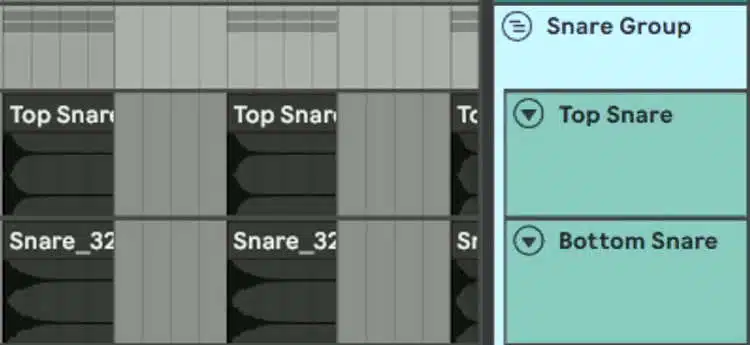
Layering snares is key when it comes to achieving a fuller, more impactful snare sound in DnB drum patterns, so you’re certainly going to want to incorporate that.
Start by selecting a snare sample with a strong transient for the top layer (focus on frequencies around 1-3 kHz) and a snare with more body or weight for the bottom layer (frequencies between 200-400 Hz).
Use EQ to carve out space for each layer, for example, cutting 2-3 dB in the low mids of the top layer to prevent overlap with the body snare.
Applying a touch of reverb (1.5-2 seconds decay time, 20-30% wet) can also help blend the snare layers into the mix properly.
And, a transient shaper can further enhance the attack if needed.
#4. Hi-Hat and Cymbal Work in DnB
Hi-hats and cymbals will help you add that signature speed, rhythm, and accents to your DnB drum patterns. So, let’s now explore how to use closed hats, open hi-hats, and crash cymbals to help you create intricate and dynamic drum n bass patterns.
-
Closed Hi-Hats for Speed and Tightness
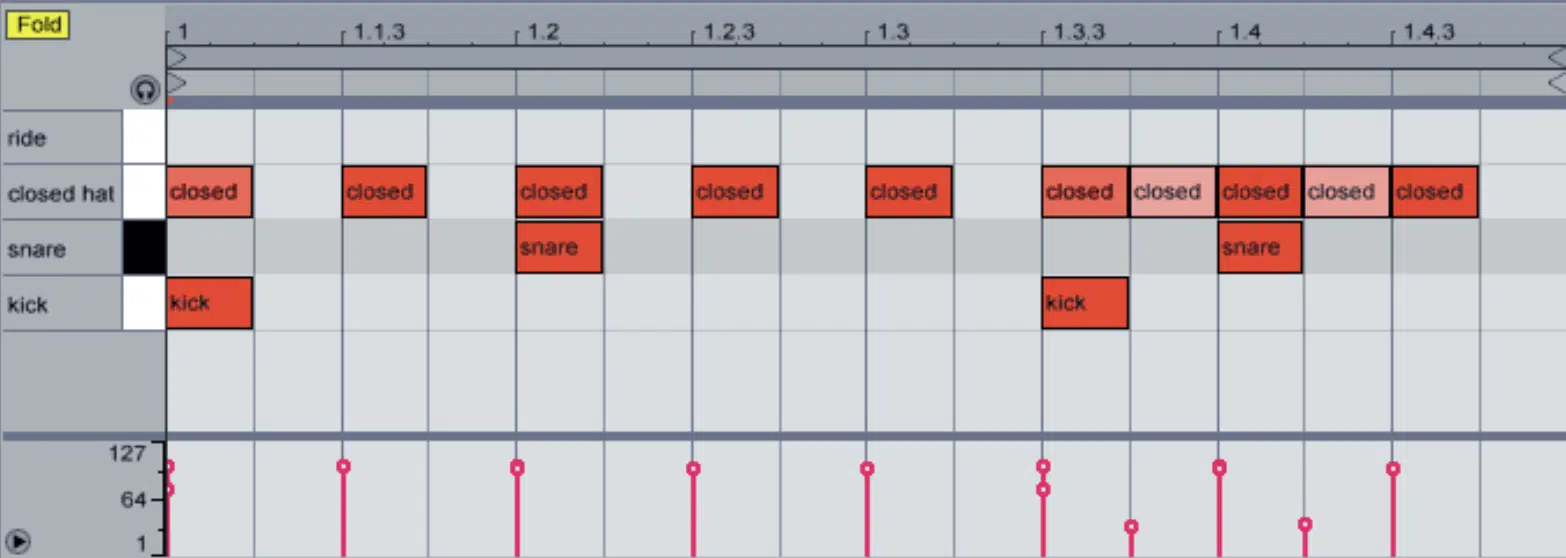
Closed hi-hats are a key element in creating that fast-paced, tight feel in drum and bass.
For speed, program your closed hats on sixteenth notes, which ensures a rapid-fire rhythm that adds ‘urgency’ to your drum patterns.
To maintain tightness, keep the velocity of your hi-hats consistent, around 70-80%.
But you’re going to want to introduce subtle variations (e.g., lowering the velocity on every fourth or eighth note) to avoid sounding robotic.
Layering two closed hi-hat samples can add depth/texture to the hi-hat groove, so try:
- One 一 With a brighter tone (EQ around 8-10 kHz)
- Another 一 With a darker tone (EQ around 2-4 kHz)
You can also experiment with panning; try slightly offsetting the panning of each hat layer (e.g., one at 10% left and the other at 10% right) to enhance the stereo field.
Applying sidechain compression to the main kick will help the closed hats duck out of the way so they don’t clash with the heavy bass drum, which I’ll break down later on.
-
Open Hi-Hats and Crash Cymbals for Accents
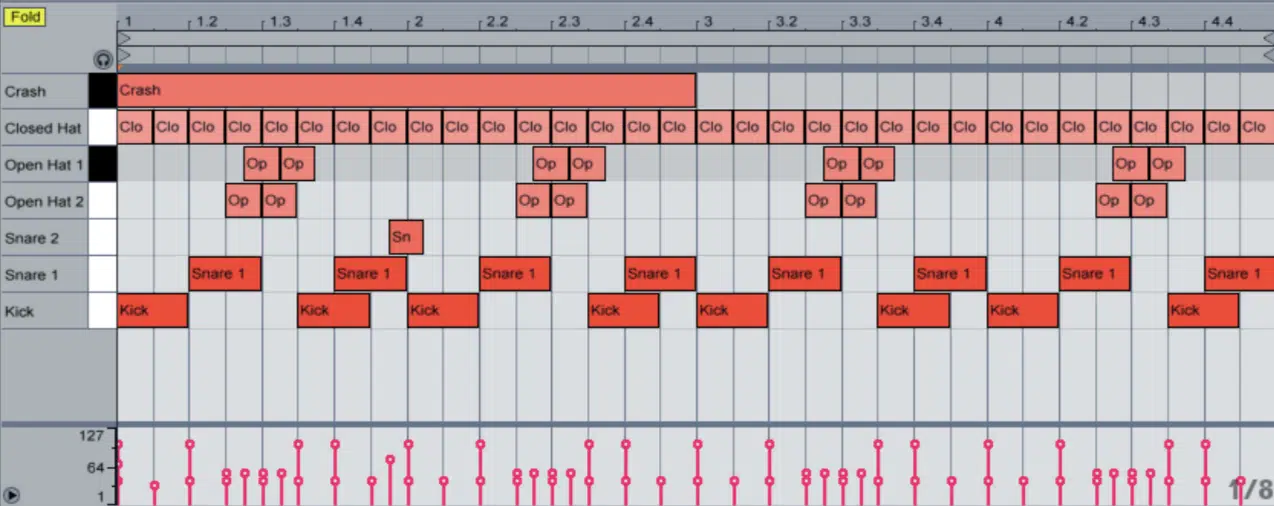
On the flip side, open hi-hats and crash cymbals are perfect for adding accents and emphasis in your DnB drum patterns.
Just make sure to use open hi-hats sparingly 一 placing them on off-beats or just before transitions, such as the first drop or second drop.
Otherwise things will sound a little too messy and cluttered.
Start out by layering your open hi-hats at 25-30% wet reverb (around 1.2 seconds decay) to create space without overpowering the rest of the drum and bass track.
For crash cymbals, automate the volume to fade slightly after each hit.
This successfully prevents it from dominating the mix and leaves more room for your bass sounds and drum samples, which you always want.
-
Rhythmic Hi-Hat Patterns for DnB
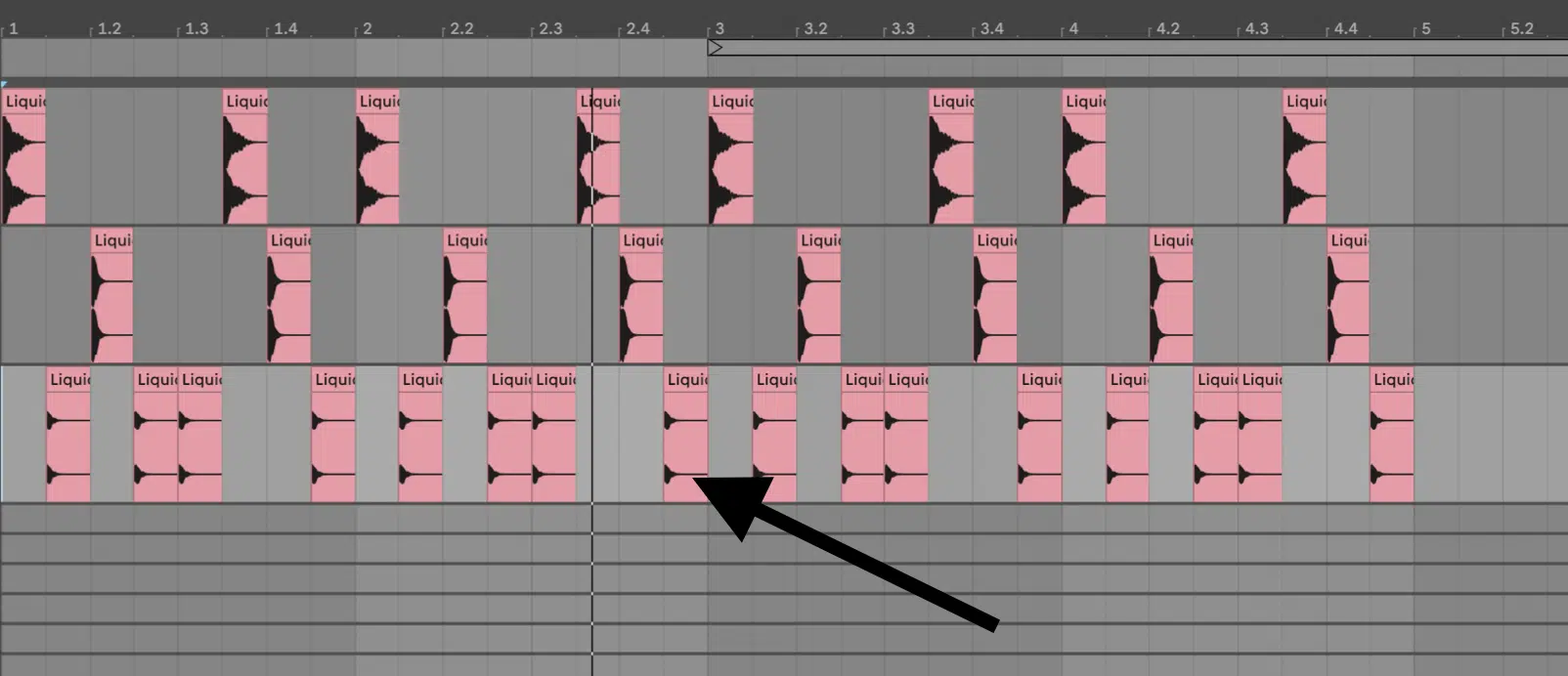
Rhythmic hi-hat patterns can make or break a drum and bass track, so make sure to play around with different note divisions like eighth and sixteenth notes.
It can make a huge difference, I promise you that (in a good way).
For a more complex pattern, you can alternate between sixteenth notes on the closed hats and quarter notes on the open hi-hats, filling the gaps in your bass drum patterns.
Applying a high-pass filter to your hi-hats, starting around 300 Hz and sweeping up to 500 Hz, can clear out any unnecessary low frequencies as we talked about.
As well as prevent clashing with your bass drum 一 no problem frequencies allowed!
NOTE: By automating slight changes in pitch (e.g., +/- 50 cents) throughout the hi-hat loop, you can keep the pattern interesting and engaging to avoid static repetition.
#5. The Role of Ghost Notes in DnB Patterns
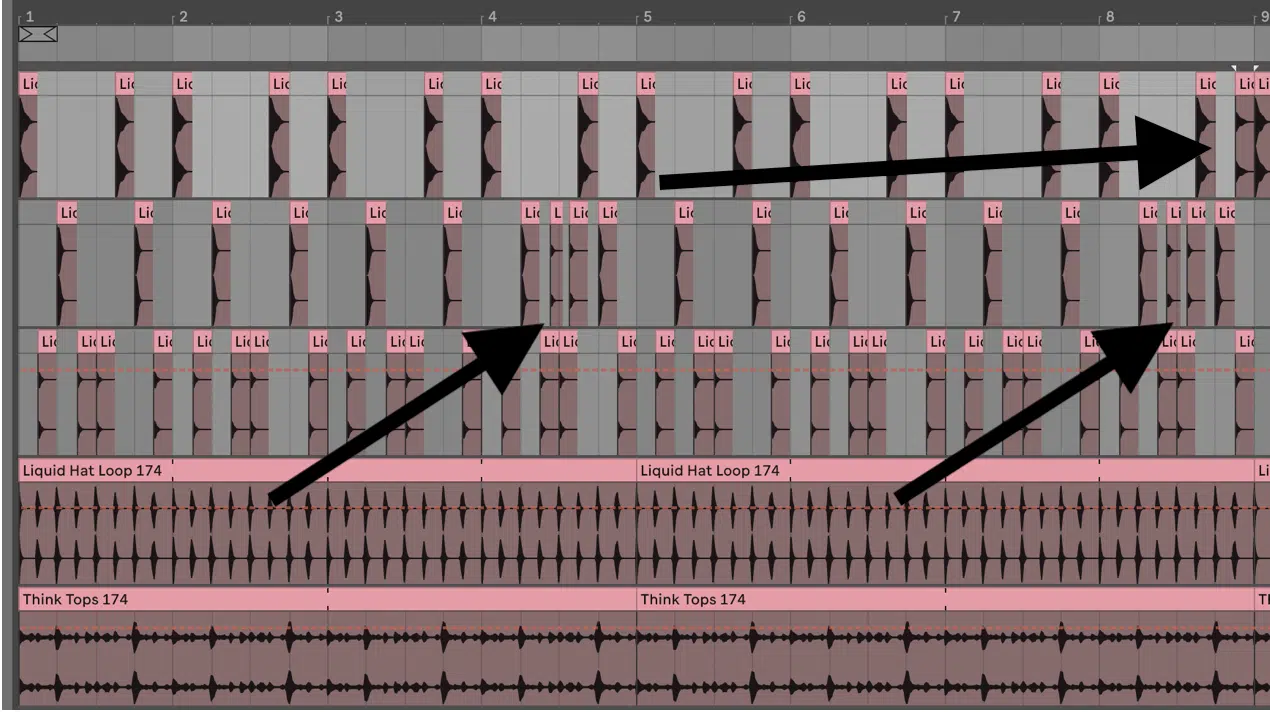
Throwing in some ghost kicks
Ghost notes seem like such a little thing, but they can actually make a big difference when it comes to impactful DnB drum patterns.
They’ll help you add intricacy/groove to your DnB drum patterns without overwhelming the main rhythm, which should always be the star of the show.
These are typically very quiet snare hits placed between the second and fourth beats, and should be programmed at a low velocity (around 15-30%) to create a dynamic flow.
For example, placing ghost snares on the 16th notes right after the main snare hits can give your drum patterns a shuffle-like feel.
It’s important to EQ these ghost hits, cutting the low end below 200 Hz to keep them from interfering with your bass drum patterns or bass sounds.
You can also slightly pan ghost snares to the left or right (around 5-10%) to add width and keep the mix from sounding too centered.
NOTE: Automating the volume of ghost snares during breakdowns or quieter sections will help maintain interest and energy in your drum and bass tracks.
#6. Drum Programming Techniques
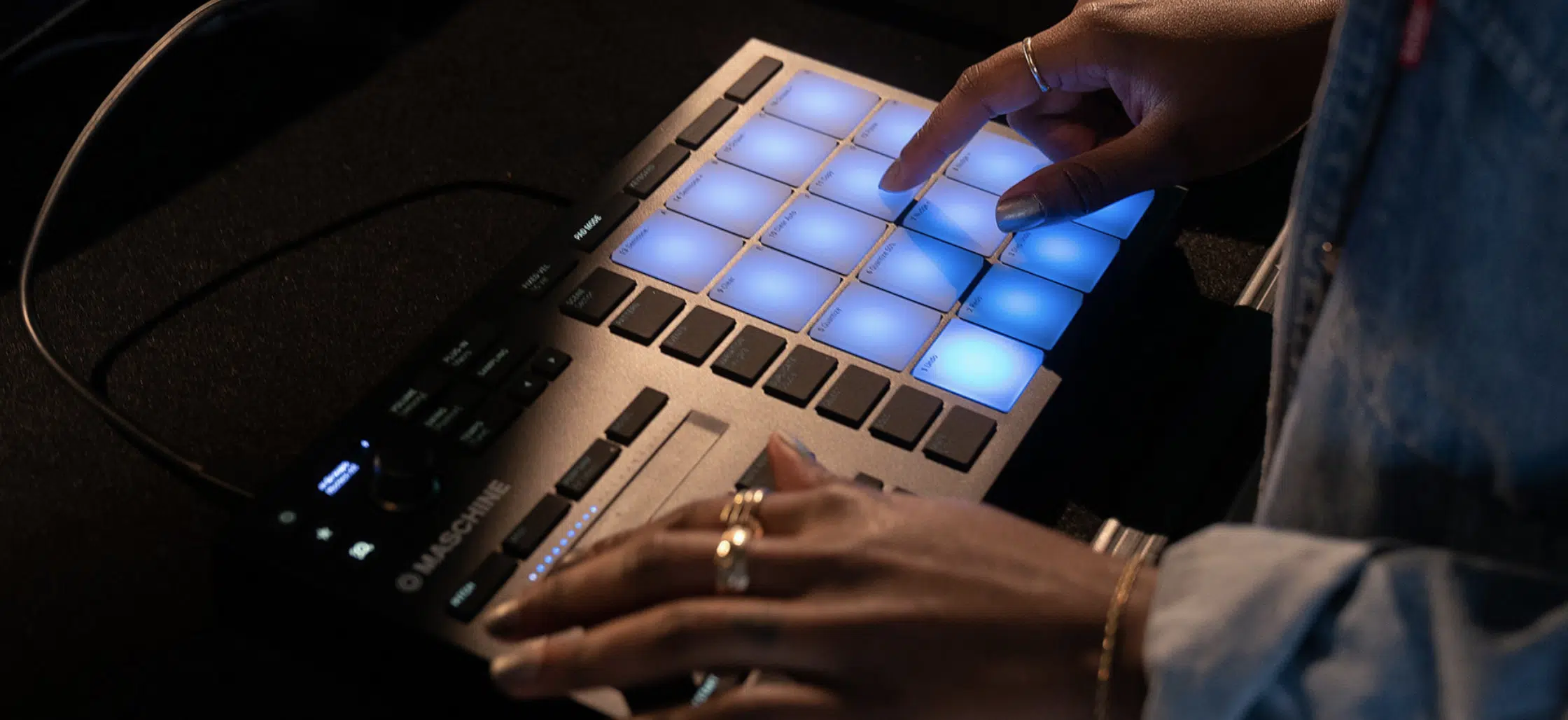
The right drum programming methods are going to really help you knock your DnB drum patterns out of the park.
You should start by quantizing your core elements (e.g., kick and snare) to a 1/16 grid.
Then, apply small timing shifts (e.g., nudge by 5-10 milliseconds) to ghost snares and hi-hats for a more human feel.
Use velocity variation to add dynamics and inspiration to your drum patterns…
Just make sure to slightly randomize velocities on hi-hats and ghost notes (within a range of 60-100%) for more natural grooves.
Layering your drum sounds with sampled breaks can provide complexity.
For instance, layering a sampled breakbeat under your own drums (programmed) and cutting low frequencies below 200 Hz on the break can create a fuller sound.
When working with complex drum samples, whether it’s your own samples or something you just grabbed, make use of sidechain compression people.
It will help the bass drum and snare to punch through, especially around 60-100 Hz for kicks and 2-3 kHz for snares.
Finally, automate subtle changes, like filtering or bit-crushing, on your top loops to prevent the pattern from becoming monotonous and boring.
#7. Layering Drum Sounds: Depth and Dimension (A Deeper Look)
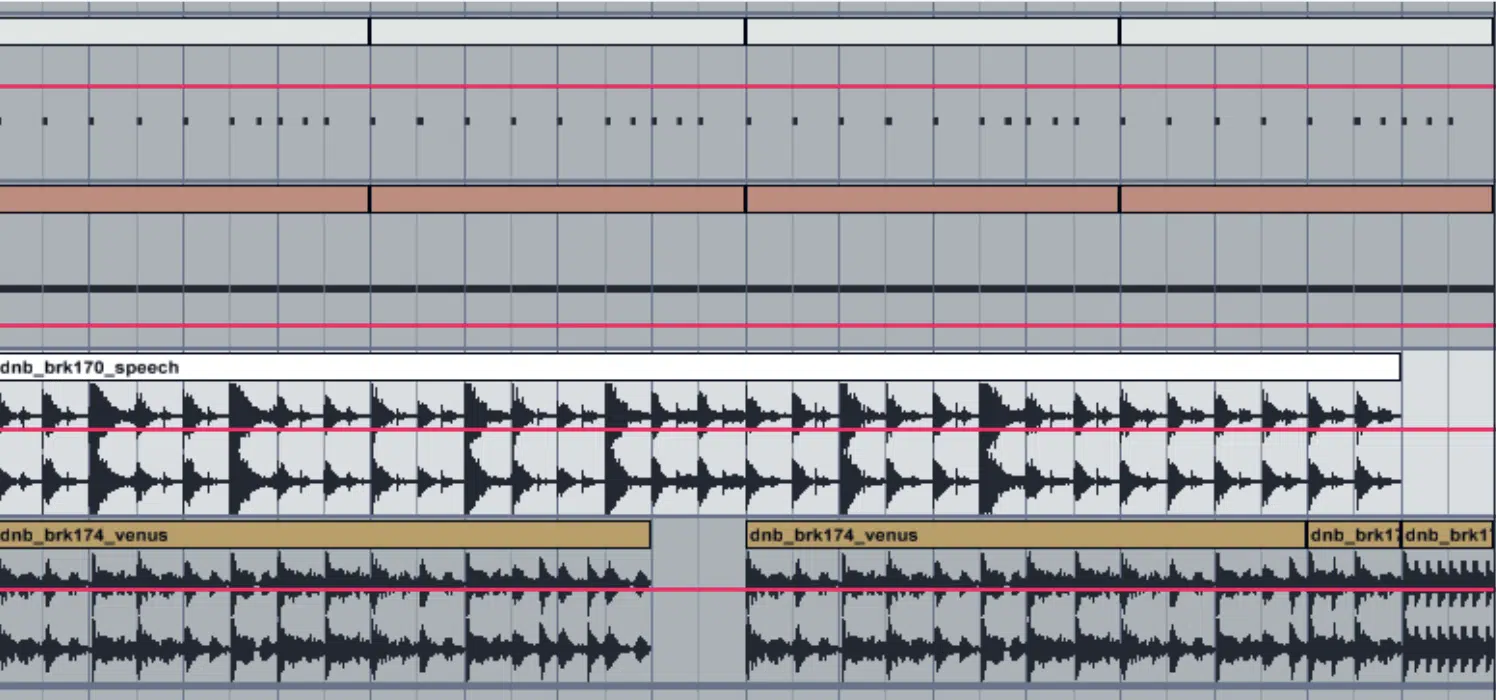
Layering drum sounds/drum breaks (shown above) is one of the most effective ways to add depth and texture to your DnB drum patterns as we just touched upon.
Start by selecting a clean bass drum for the low-end punch, EQ’d around 50-70 Hz, and layer it with a midrange kick that adds body (around 100-150 Hz).
For snares, pair a snappy snare with a lower, more resonant sample…
Cutting out overlapping frequencies using EQ, for instance, by reducing 2-3 dB around 400 Hz in the upper layer to allow the lower snare more room to shine.
Don’t forget to apply reverb and delay strategically 一 a snare reverb with a 1.5-second decay time and around 25% wet can add space without washing out the punch.
For hi-hats and any other percussive element, layer with a high-frequency white noise sample (cut at around 5 kHz) to give your pattern a more organic, natural feel.
NOTE: Use many unison voices in your layers to create wider, more immersive drum patterns that stand out in the stereo field.
Generally speaking, it makes things sound much more epic and show-stopping.
#8. Breakbeats: The Backbone of DnB
When it comes to DnB drum patterns (and some other electronic music genres with the same particular style), breakbeats are the driving force behind that iconic, fast-paced rhythm. So, for this next section, let’s explore the history of breakbeats and how you can manipulate and layer them to create fresh/exciting drum and bass rhythms of your own.
-
What Are Breakbeats? Origins and Impact on DnB
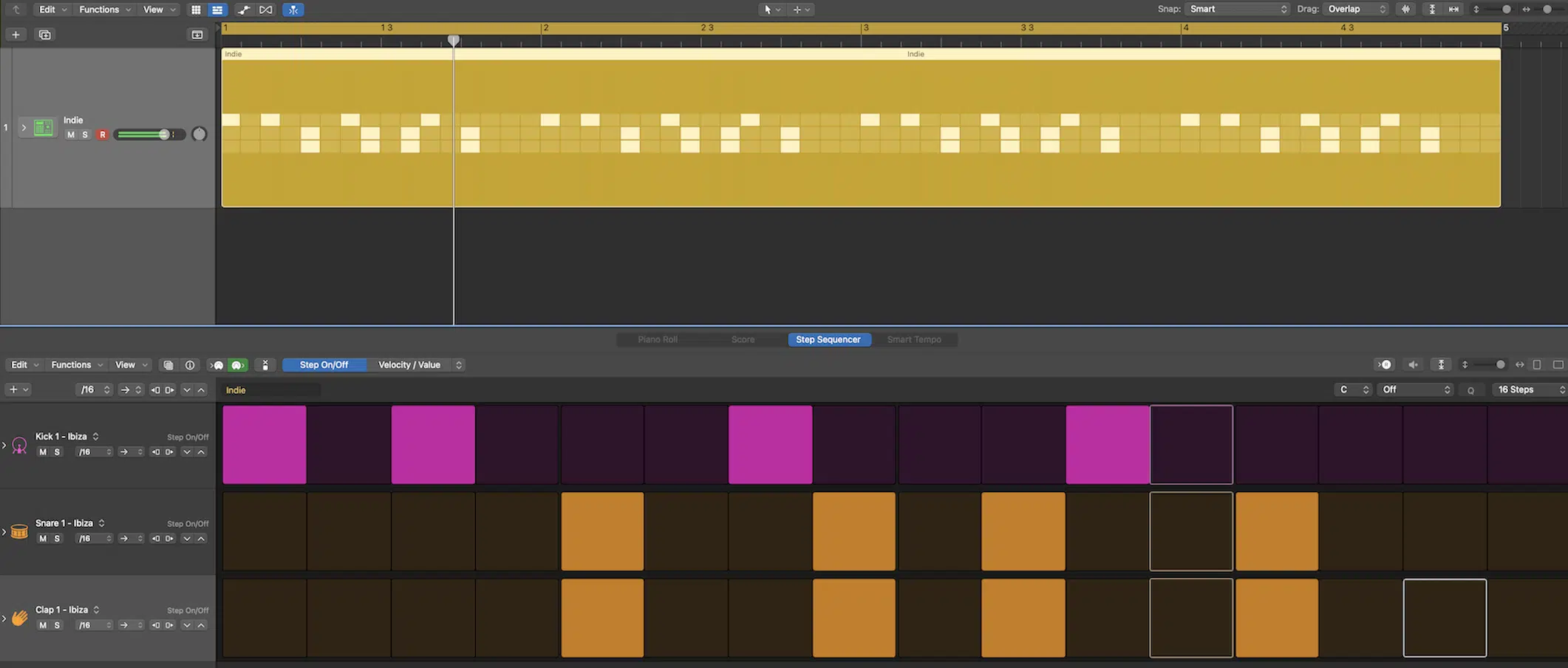
Breakbeats originated from sampling the percussive breaks in funk records and, since then, have become a foundation in drum and bass production.
The classic technique involves:
- Taking a drum-heavy section of a song
- Isolating the break
- Looping it to form the core of your drum patterns
Breakbeats bring a raw, organic feel to DnB drum patterns 一 adding energy and complexity that is not only epic, but undeniably addictive.
For example, many early DnB producers relied on the sampled breaks from tracks like “Apache” by The Incredible Bongo Band.
It provided the rhythmic blueprint for modern drum and bass tracks.
The impact of breakbeats extends beyond their rhythm…
They provide texture and groove that make DnB tracks feel more alive, especially when combined with modern drum processing techniques.
Side note, if you want to learn how to create energetic breakbeats that shutdown the club, we got you covered.
-
The Amen Break: Analyzing the Most Iconic DnB Break

The Amen Break is arguably the most famous breakbeat in drum and bass, sampled from “Amen, Brother” by The Winstons.
This six-second drum solo has been chopped, rearranged, and manipulated in more DnB (drum n bass) tracks that I can count, seriously.
It’s because it excels in providing the perfect blend of complexity and groove.
The Amen Break features rapid hi-hats, a snappy snare, and a syncopated bass drum that drives the rhythm forward.
To use the Amen Break in your track, start by chopping it into individual slices…
Focus on isolating the first snare, second kick, and any percussive elements in between to create custom drum patterns.
When layering the Amen Break over your existing DnB drum patterns, high-pass filter it at around 150-200 Hz to avoid clashes with your primary bass drum and bass sounds as I mentioned earlier.
-
Chopping and Rearranging Breakbeats for Fresh Patterns: Breaking it Down
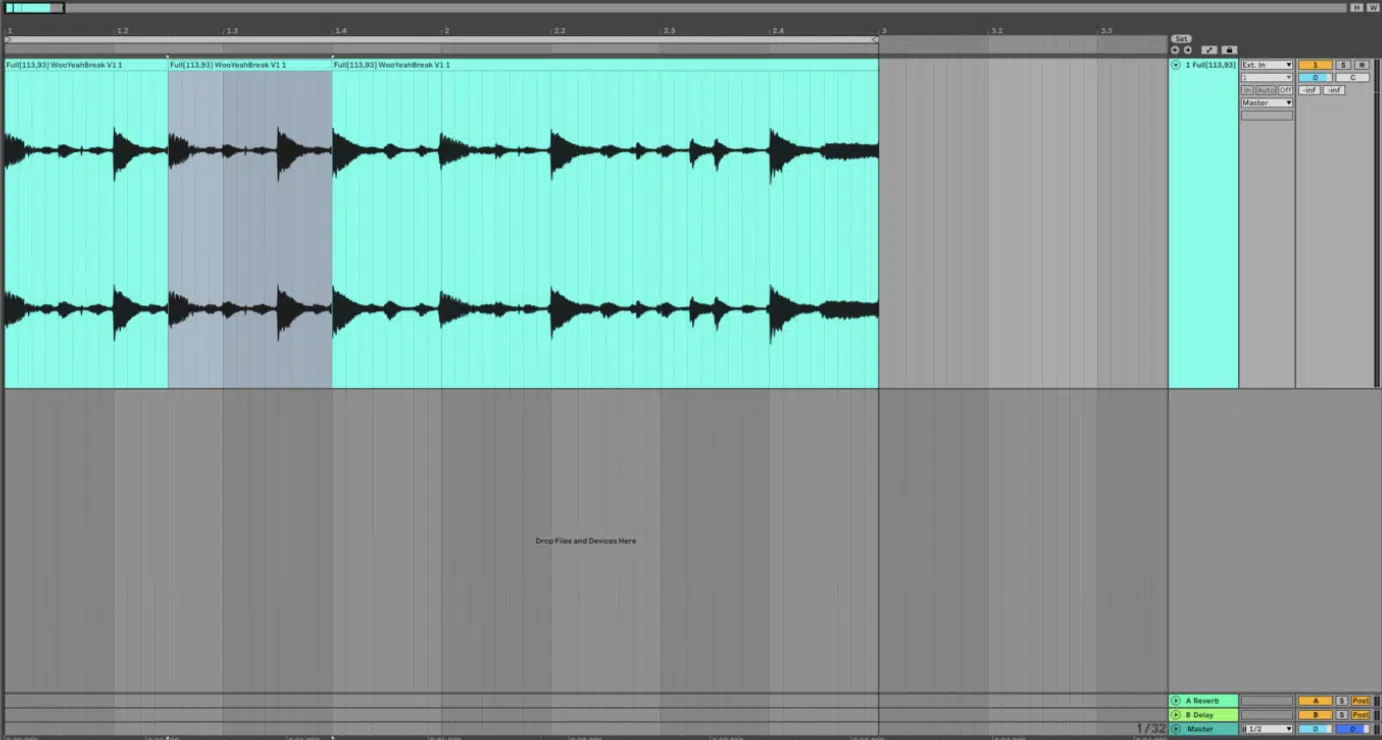
Chopping up breakbeats is one of the best ways to inject freshness into your DnB drum patterns, hands down.
Using tools like Slicex (in FL Studio) or Slice-to-MIDI function (in Ableton), you can break down a sampled breakbeat into individual hits for full control over your rhythm.
Once you’ve sliced your breakbeat, rearrange the hits to create unique patterns.
Try placing the first kick on beat 1 and the second snare on beat 2, while filling the gaps with hi-hat slices and ghost snares.
Be sure to use EQ to carve out space for your chopped break 一 cutting 200-300 Hz to prevent frequency build-up in the low mids.
You can also stretch sections of the breakbeat using time-stretching effects to create variations and keep the listener engaged.
#9. Drum Sound Design for DnB
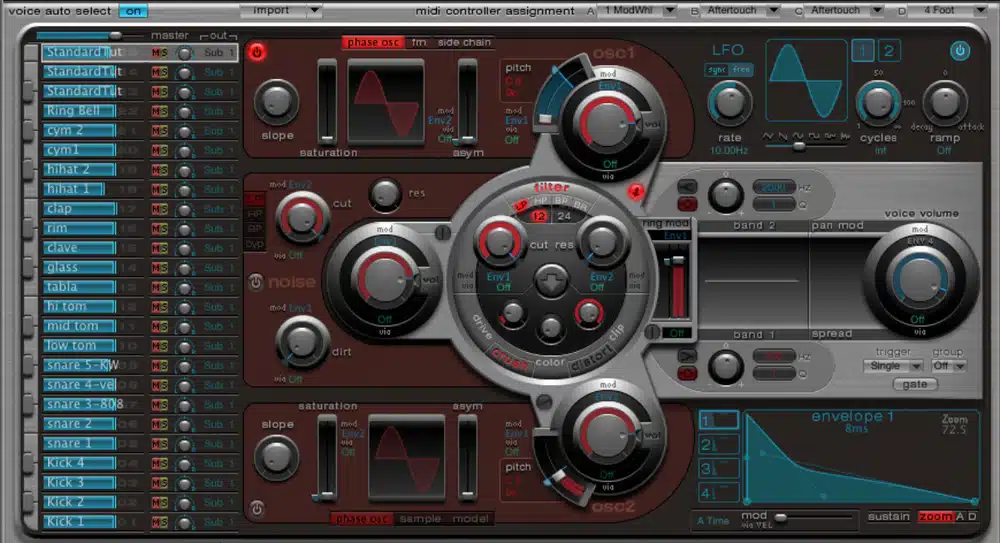
Sound design is the key to achieving powerful, unique drum sounds that stand out in drum and bass production (not to mention my favorite subject in the world).
When designing bass drum sounds, focus on enhancing the low end by boosting around 50-60 Hz using a bell EQ filter.
Again, be careful not to overcrowd the frequency spectrum.
For snares, start with a bright snare sample and layer it with a lower, more resonant sound (EQ around 200-250 Hz), then apply saturation to add warmth and character.
To make your hi-hats stand out, add a touch of white noise (around 8-10 kHz) and modulate the pitch slightly throughout the loop to prevent a gross static feel.
Incorporating subtle distortion or bit-crushing on percussion can also help give your drum patterns a more aggressive, textured edge.
Always leave enough empty space in your mix by carefully balancing the levels of each drum sound 一 allowing your bass tracks to shine through without being masked.
A good producer (which I’m sure you are or are striving to be), knows that each and every element needs to shine in its own right.
-
Pro Tip
When working on sound design for your drum and bass tracks, try using parallel compression (shown above) on your drum bus for added punch and depth.
Take a duplicate of your drum track, heavily compress it with a high ratio (8:1 or higher) and fast attack and release settings.
Then, blend it back in with the original track at a low volume (around -10 to -15 dB).
This technique allows the transient detail of your original drums to shine through while giving your bass drum and snares extra weight and presence.
6 Bonus Tips For Creating DnB Drum Patterns
As a special bonus, I’ve included 6 bonus tips for creating the most epic DnB drum patterns in the game. This is for both amateur producers who want to push the limits and professionals who want to step it up even further.
Tip #1: Use Subtle Variations in Hi-Hat Velocity for More Realism

A great way to humanize your DnB drum patterns is by introducing slight velocity variations in your hi-hats.
Instead of keeping them static, adjust the velocity between 70-90% randomly within a 4- or 8-bar loop, which adds subtle dynamics and prevents a mechanical sound.
You can also try modulating the hi-hat sample’s pitch by a few cents (±10 cents) to add even more realism and spice things up a little like I said before.
Tip #2: Experiment with Triplets and Quintuplets to Add Swing
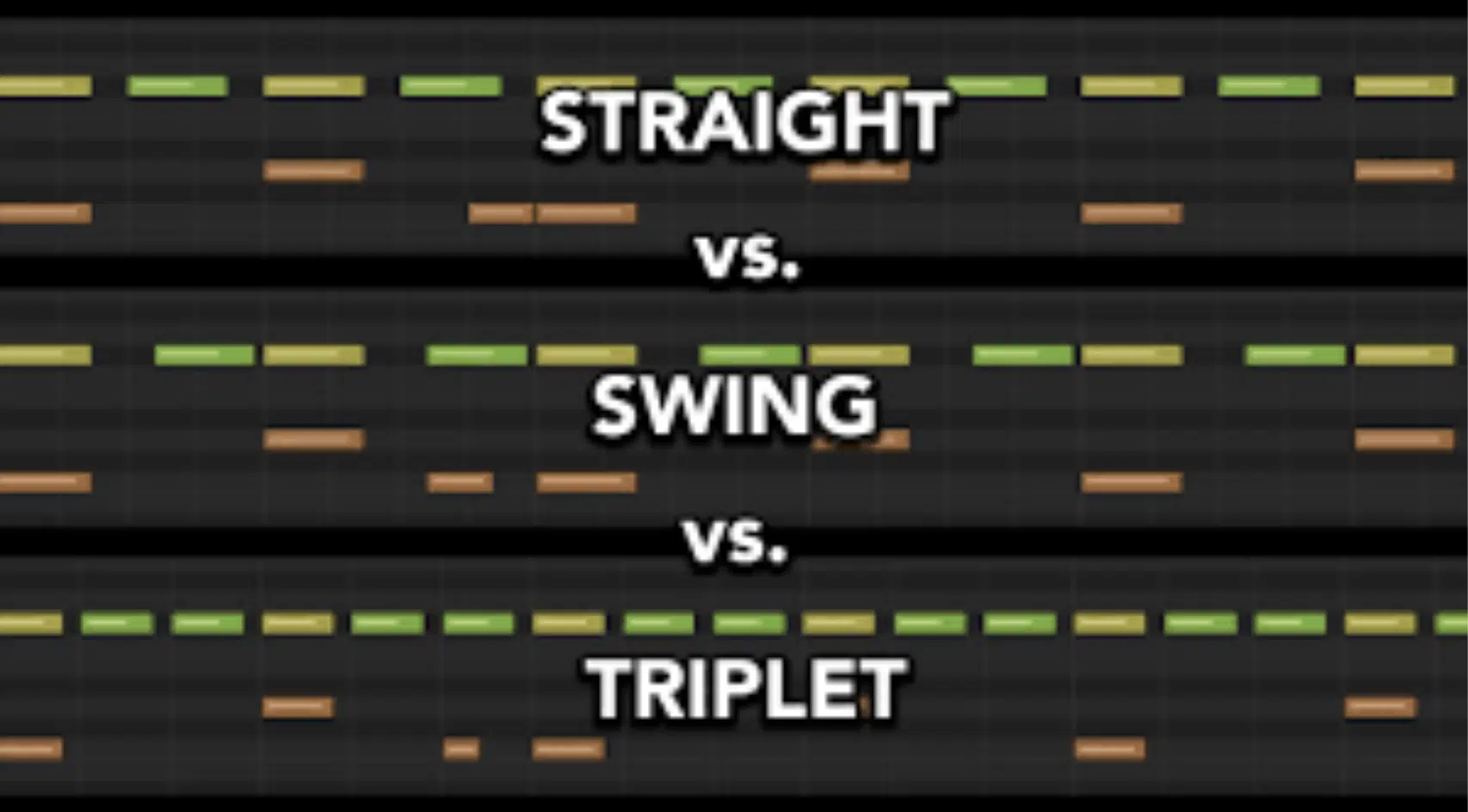
Introducing triplet or quintuplet rhythms into your DnB drum patterns can create an interesting swing feel that breaks the monotony of straight 16th notes.
Try using a quintuplet grid on hi-hats or ghost snares in transitions or build-ups to add rhythmic complexity.
Set your DAW’s grid to triplets and place your bass drum on the first triplet (groovy, baby!).
This creates syncopation that stands out, especially in breakdowns or intros of bass drum patterns.
Tip #3: Add Reverse Cymbals or Snares for Transition Effects
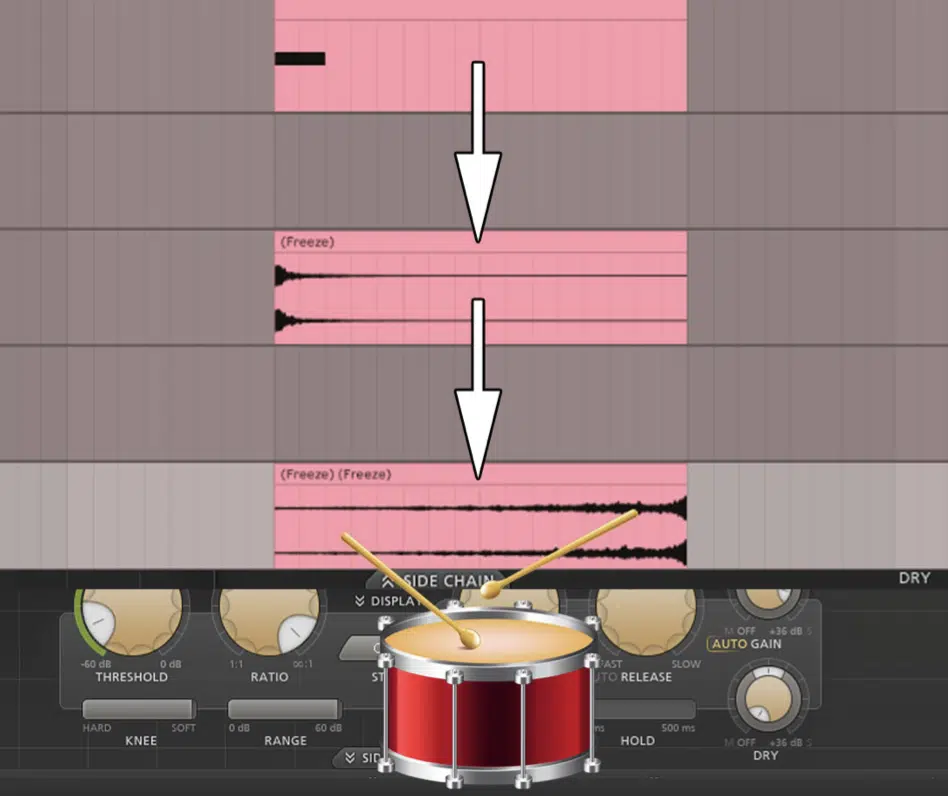
Reverse snare
Reverse cymbals and snares are fantastic for creating smooth transitions in your DnB drum patterns, especially before the first drop or second drop.
If you’re into electronic music, you certainly know how important the drops are.
To create a reverse effect, simply reverse a cymbal or snare sample, apply a reverb with a long decay time (2.5-3 seconds), and automate the volume fade-in.
Place it just before the drop or a major change in the drum pattern to build tension and anticipation that people go crazy for.
Tip #4: Incorporating Drum Rolls and Fills to Build Energy
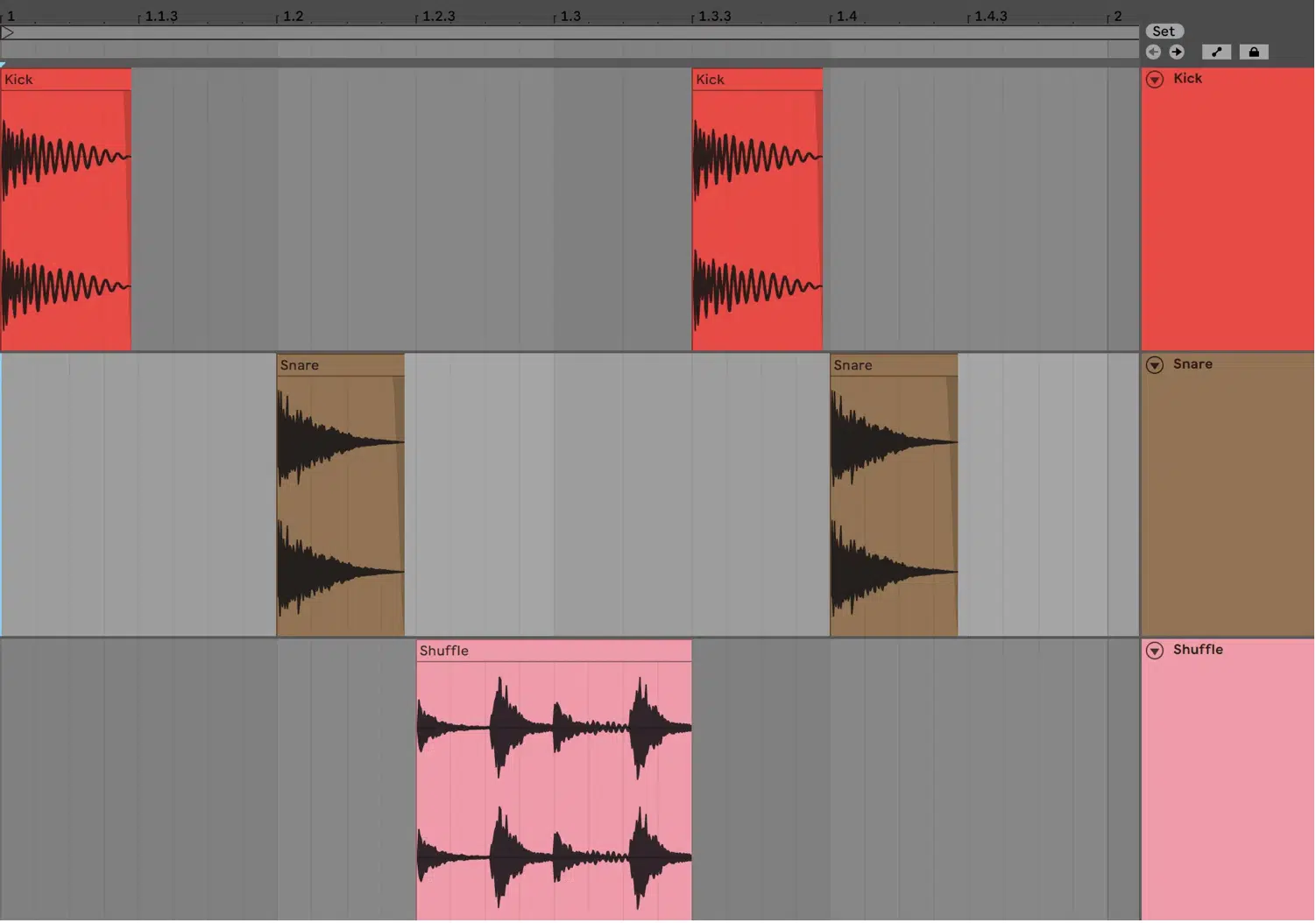
Drum rolls and drum fills are a great way to build energy before drops or breakdowns.
Try programming sixteenth or thirty-second note rolls on the snare 一 increasing the velocity gradually (starting from 50% up to 100%) to build tension.
You can also layer additional percussive elements like toms or pitched snares to create variety, adding reverb with a short decay time (around 1.2 seconds).
This will keep the rolls tight yet impactful.
Tip #5: Using Many Unison Voices for a Fuller, Wider Drum Sound

Using Many Unison Voices can beautifully thicken your DnB drum patterns so they feel fuller and wider in the mix.
Start by layering multiple copies of your snare or bass drum, and detune them slightly (e.g., ±5-10 cents) to create a wide, chorus-like effect.
You can also pan each layer slightly left or right (10-20%) to spread the drum sound across the stereo field.
This technique works especially well for bass drums and snares, which gives them a massive presence without overcrowding the mix.
Remember you always want your drum pattern to stand out and sound professional, not be a messy, amateurish disaster scene.
Tip #6: Polyrhythms
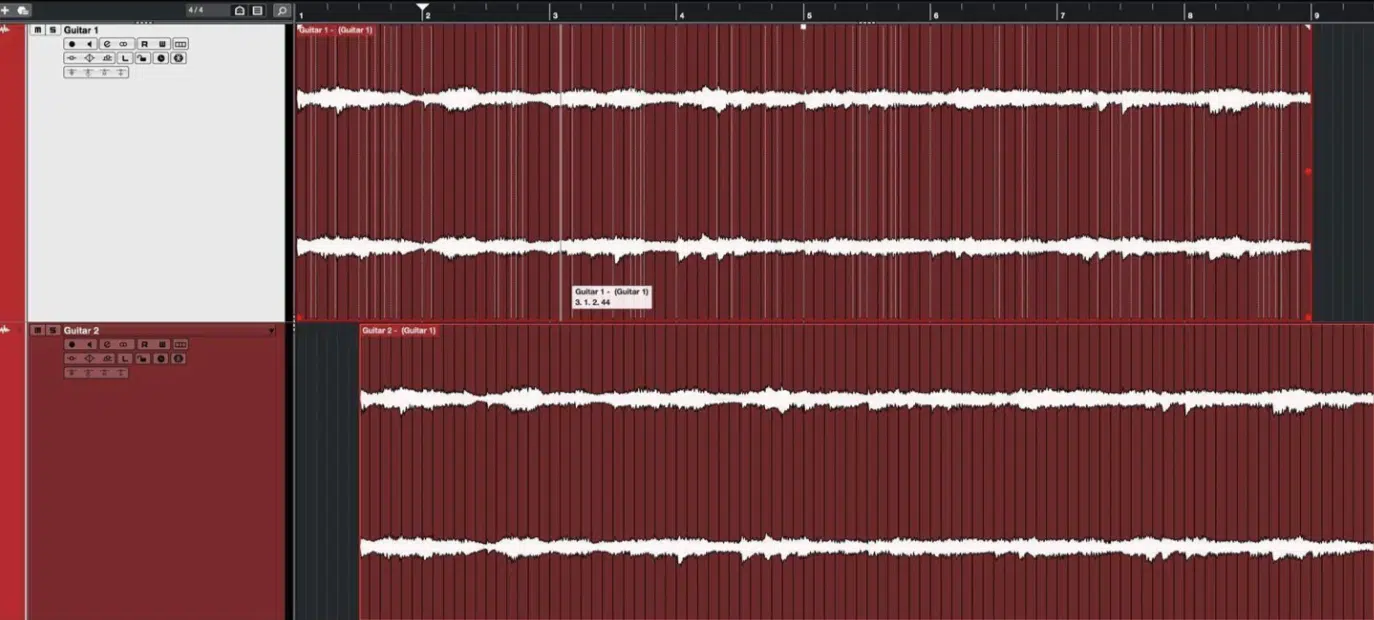
Polyrhythms are an advanced technique for adding complexity to your DnB drum patterns.
Try layering a 3/4 hi-hat pattern over a standard 4/4 bass drum pattern to create an overlapping, offbeat feel that keeps the listener engaged.
Just remember to make sure that your polyrhythmic layers are balanced by carefully EQ’ing each element and keeping their levels controlled.
You don’t want any nonsense or problems with the frequency spectrum.
DnB Drum Patterns: Final Thoughts
Creating DnB drum patterns, as you now know, is all about precision, groove, and getting super creative.
Plus, it’s key to master sound design, layering techniques, and advanced tips like syncopation and sidechain compression.
You have to really focus on detail and make sure each element in the frequency spectrum has its own space.
Luckily, by using the tips, tricks, and techniques we covered today, you’ll be well on your way to laying down killer DnB drum patterns all day.
If you’re really looking for the absolute best DnB drum samples in the game, you’ve got to check out this legendary Drum & Bass MIDI Drum Collection.
It includes over 250 expertly designed MIDI drum patterns (with epic kicks, snares, hi-hats, full grooves, etc.).
It’s plug-and-play, so you can drag and drop the MIDI files into your DAW to instantly create pro-level DnB drum patterns.
Whether you’re a beginner or an advanced producer, this collection will help you understand DnB drum patterns like a boss (it’s like having the cheat codes).
Plus, help enhance your DnB production skills like you never imagined.
Bottom line, mastering DnB drum patterns does take a little time, but with dedication and the right tools, you’ll be creating standout tracks that turn heads in no time.
So keep experimenting, stay creative, and never stop refining/growing your skills.
Until next time…







Leave a Reply
You must belogged in to post a comment.